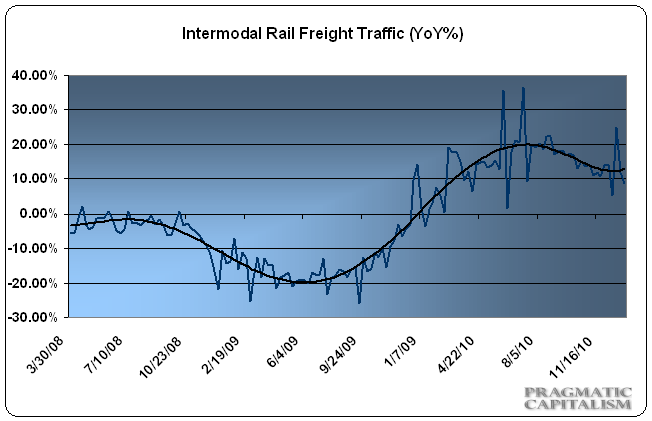The AAR reported a strong end to the year in rail data. What looked like a fairly weak recovery in rail data through much of 2009 has actually turned into a sustained double digit year of growth through 2010. Although the economy is a long way from full recovery this data confirms that the trend is moving in the right direction (via AAR):
“The Association of American Railroads (AAR) today reported an increase in weekly rail traffic for the post-holiday week ending Jan. 1, 2011, with U.S. freight railroads originating 240,073 carloads, up 5.6 percent compared with the same week in 2009. Intermodal traffic for the week totaled 166,894 trailers and containers, up 11.9 percent compared with the same week in 2009, with container volume up 10.9 percent and trailer volume up 18.1 percent.
For the full 52 weeks of 2010, U.S. railroads originated 14,820,128 carloads, up 7.3 percent from last year, but down 10 percent from 2008. Cumulative intermodal traffic totaled 11,282,336 trailers and containers, up 14.2 percent from 2009, but down 1.9 percent when compared with 2008. A complete summary of the annual rail traffic data will be included in the January 2011 Rail Time Indicators report which will be released by AAR on Monday, January 10, 2011.
“Rail traffic growth in 2010 is clearly a positive development, and reflects a growing economy as well as solid, dependable service on the part of the railroads,” said AAR Senior Vice President John T. Gray. “However, this growth is certainly slower than any of us would like, and rail traffic still has a long way to go to full recovery.”
In the final week of 2010, 16 of the 19 carload commodity groups increased from the comparable week in 2009. Those carload commodity groups posting double-digit increases included: metallic ores, up 111.7 percent; lumber and wood products, up 35.7 percent; farm products excluding grain, up 32.3 percent; pulp, paper and allied products, up 19.7 percent; metals and products, up 19 percent; stone, clay and glass products, up 18.3 percent; crushed stone, sand and gravel, up 14.4 percent; chemicals, up 12.1 percent; and petroleum products and food and kindred products, both up 10.7 percent. Commodities reporting declines were coke, down 5.4 percent, and coal, down 2 percent.
Carload volume on Eastern railroads was up 2.5 percent compared with 2009. In the West, carload volume was up 7.4 percent compared with the same week in 2009.”

Source: AAR
Mr. Roche is the Founder and Chief Investment Officer of Discipline Funds.Discipline Funds is a low fee financial advisory firm with a focus on helping people be more disciplined with their finances.
He is also the author of Pragmatic Capitalism: What Every Investor Needs to Understand About Money and Finance, Understanding the Modern Monetary System and Understanding Modern Portfolio Construction.

Comments are closed.